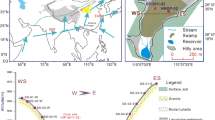Abstract
A 6.2 m thick core of Gucheng Lake sediment provided a 3600 years record of climate change. The contents of the TOC in the core changed from 2.63% to 8.48%, and the δ13C values of organic matter were from −21.54% to −27.3%. The TOC/TN ratios indicated that the organic materials in sediments were from lake plankton and land-derived plants.
The 2.9–22 m core interval with high TOC/TN ratios, low δ13C values and low contents of TOC indicated a cold climate stage. The 6.2–5.5 m and 0.4–0.1 m intervals were characterized by low TOC/TN ratios, high δ13C values and high contents of TOC, and reflected temperate climate stages.
Similar content being viewed by others
References
Bender, M. M., 1971. Variations in the13C/12C ratios of plants in relation to the pathway of photosynthetic carbon dioxide fractionation.Phytochemistry. 10: 1234–1244.
Cormie, A. B., Schwarez, H. P., 1994. Stable isotopes of nitrogen and carbon of North American White-tailed deer and implications for paleodictary and other food web studies. Palacogeogr.,Palaeoclimatol., Palaeoecol. 107: 227–241.
Degens, E. T., 1969. Biogeochemistry of stable carbon isotocpe.In: Organic Geochemistry (eds, G. Eglinton and M. T. J. Murphy) pp. 304–329.
Hudson, J. D., Anderson, T. F., 1989. Ocean temperatures and isotoic compositions through time.Tran. R. Soc. Edinburg Earth Sci. 80: 183–192.
Krantz, D. E., Williams, D. F., Jones, D. S., 1987. Ecological and palaeoenvironmental information using stable isotope profiles from living and fossi molluses.Palaeogeogr., Palacoclimatol., Palaeoecol. 58: 249–266.
Ma, Y., Wang, S. M., Hongxi, P., 1996. Singnificance of diatom and pigment in the study on palaeoenvironmental evolution.Journal of Lake Sciences 8(1): 16–26. (in Chinese)
Marshall, J. D., 1992. Climatie and oceanographic isotopic signals from the carbonate rock record and their preservation.Geol. Mag. 129: 143–160.
Nakai, N., 1986. Paleoenvironmental features of Lake Biwa deduced from carbon isotope compositions and organic C/N ratios of the upper 800 m samples of 1400 m cored column.Proc. Jap. Acad. 62B: 279–282.
Nakai, N., Koyama, M., 1987. Reconstruction of paleoenvironment from the view-points of the inorganic constituents, C/N ratio and carbon isotopic ratio in the 1400 m core taken from Lake Biwa,In: S. Horie (Editor), History of Lake Biwa. Kyoto Univ. Contrib. pp. 137–156.
Ran, G. H., Froelich, P. N., Takahashi, T. et al., 1991. Does sedimentary organic δ13C record variations in Quaternary ocean CO2 (aq)?Paleoceanography 6: 335–347.
Sackett, W. M., Eckelman, W. R., Bender, M. L. et al., 1965. Temperature dependence of carbon isotope composition in marine plankton and sediments.Science 148: 235–237.
Smith, B. N., Epstein, S., 1971. Two categories of13C/12C ratios for higher plants.Plant Physiol. 47: 380–384.
Teeri, J. A., Stowe, L. G., 1976. Climate patterns and the distribution of C4 grasses in North America.Oecologia. 23: 1–12.
Tiezen, L. L., 1978. Carbon isotope fractionation in biological materials.Nature 276: 97–98.
Van der Merwe, N. J., 1982. Carbon isotopes, photosynthesis and archacology.Am. Sci. 70: 596–606.
Wang, S. M., 1995. Paleolimnology of Hulun Lake. Publishing House of Chinese Science and Technology University, Hefei.
Xiang, L., Wang, S. M., 1994. Determination of recent varying, sedimentation rates in Gucheng Lake using210Pb and137Cs.Mem. of Nanjing Inst. of Geog. and Limnol. Acad. Sinica. 11: 70–82. (in Chinese)
Yang, X. D., Wang, S. M., Ji, L. et al., 1994. Spore-pollen assemblage and environmental change of Gucheng Lake since Late Holocene.Journal of Lake Sciences. 6(3): 233–239. (in Chinese)
Author information
Authors and Affiliations
Additional information
Project 49372129 supported by NSFC.
Rights and permissions
About this article
Cite this article
Ji, S., Matsumoto, R. & Su-min, W. A 3600 years paleoclimatic change inferred from organic δ13C and TOC/TN of the Gucheng Lake sediments, southeast China. Chin. J. Ocean. Limnol. 15, 279–284 (1997). https://doi.org/10.1007/BF02850885
Received:
Accepted:
Published:
Issue Date:
DOI: https://doi.org/10.1007/BF02850885



